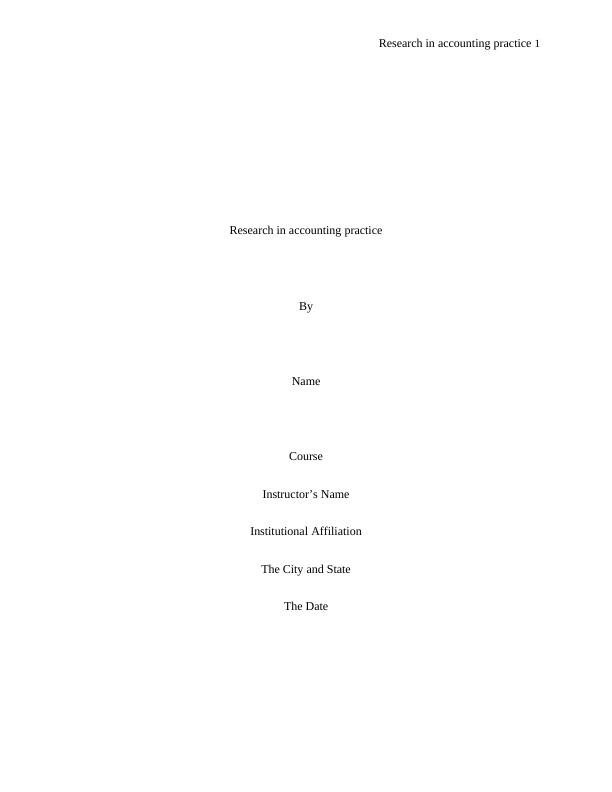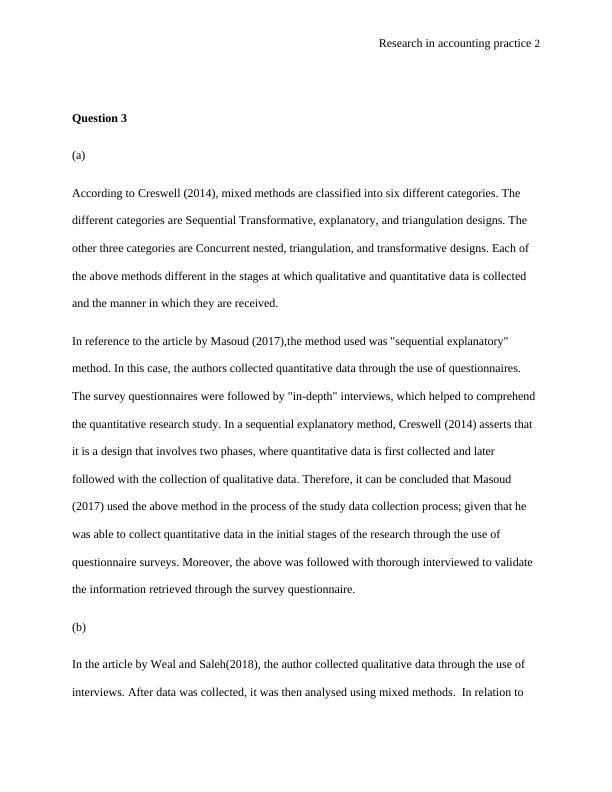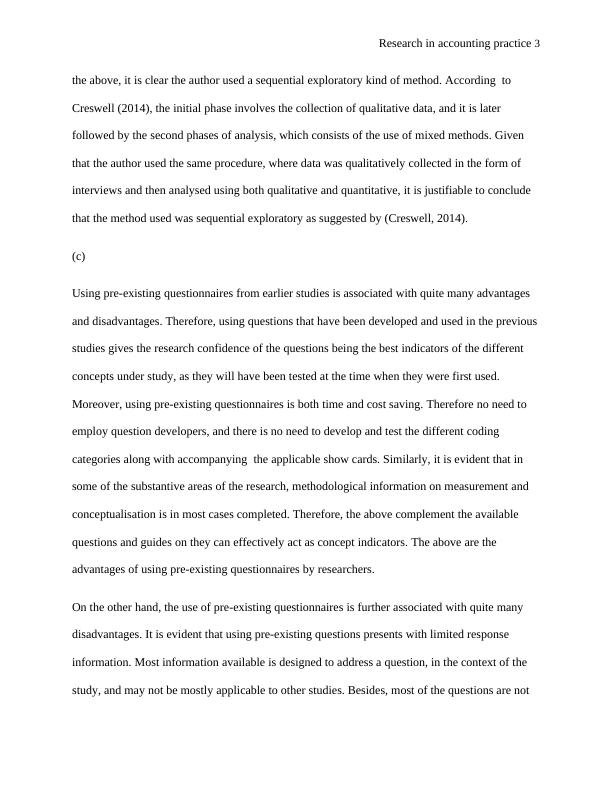Research in Accounting Practice
Added on 2023-03-30
7 Pages1417 Words59 Views
Research in accounting practice 1
Research in accounting practice
By
Name
Course
Instructor’s Name
Institutional Affiliation
The City and State
The Date
Research in accounting practice
By
Name
Course
Instructor’s Name
Institutional Affiliation
The City and State
The Date

Research in accounting practice 2
Question 3
(a)
According to Creswell (2014), mixed methods are classified into six different categories. The
different categories are Sequential Transformative, explanatory, and triangulation designs. The
other three categories are Concurrent nested, triangulation, and transformative designs. Each of
the above methods different in the stages at which qualitative and quantitative data is collected
and the manner in which they are received.
In reference to the article by Masoud (2017),the method used was "sequential explanatory"
method. In this case, the authors collected quantitative data through the use of questionnaires.
The survey questionnaires were followed by "in-depth" interviews, which helped to comprehend
the quantitative research study. In a sequential explanatory method, Creswell (2014) asserts that
it is a design that involves two phases, where quantitative data is first collected and later
followed with the collection of qualitative data. Therefore, it can be concluded that Masoud
(2017) used the above method in the process of the study data collection process; given that he
was able to collect quantitative data in the initial stages of the research through the use of
questionnaire surveys. Moreover, the above was followed with thorough interviewed to validate
the information retrieved through the survey questionnaire.
(b)
In the article by Weal and Saleh(2018), the author collected qualitative data through the use of
interviews. After data was collected, it was then analysed using mixed methods. In relation to
Question 3
(a)
According to Creswell (2014), mixed methods are classified into six different categories. The
different categories are Sequential Transformative, explanatory, and triangulation designs. The
other three categories are Concurrent nested, triangulation, and transformative designs. Each of
the above methods different in the stages at which qualitative and quantitative data is collected
and the manner in which they are received.
In reference to the article by Masoud (2017),the method used was "sequential explanatory"
method. In this case, the authors collected quantitative data through the use of questionnaires.
The survey questionnaires were followed by "in-depth" interviews, which helped to comprehend
the quantitative research study. In a sequential explanatory method, Creswell (2014) asserts that
it is a design that involves two phases, where quantitative data is first collected and later
followed with the collection of qualitative data. Therefore, it can be concluded that Masoud
(2017) used the above method in the process of the study data collection process; given that he
was able to collect quantitative data in the initial stages of the research through the use of
questionnaire surveys. Moreover, the above was followed with thorough interviewed to validate
the information retrieved through the survey questionnaire.
(b)
In the article by Weal and Saleh(2018), the author collected qualitative data through the use of
interviews. After data was collected, it was then analysed using mixed methods. In relation to

Research in accounting practice 3
the above, it is clear the author used a sequential exploratory kind of method. According to
Creswell (2014), the initial phase involves the collection of qualitative data, and it is later
followed by the second phases of analysis, which consists of the use of mixed methods. Given
that the author used the same procedure, where data was qualitatively collected in the form of
interviews and then analysed using both qualitative and quantitative, it is justifiable to conclude
that the method used was sequential exploratory as suggested by (Creswell, 2014).
(c)
Using pre-existing questionnaires from earlier studies is associated with quite many advantages
and disadvantages. Therefore, using questions that have been developed and used in the previous
studies gives the research confidence of the questions being the best indicators of the different
concepts under study, as they will have been tested at the time when they were first used.
Moreover, using pre-existing questionnaires is both time and cost saving. Therefore no need to
employ question developers, and there is no need to develop and test the different coding
categories along with accompanying the applicable show cards. Similarly, it is evident that in
some of the substantive areas of the research, methodological information on measurement and
conceptualisation is in most cases completed. Therefore, the above complement the available
questions and guides on they can effectively act as concept indicators. The above are the
advantages of using pre-existing questionnaires by researchers.
On the other hand, the use of pre-existing questionnaires is further associated with quite many
disadvantages. It is evident that using pre-existing questions presents with limited response
information. Most information available is designed to address a question, in the context of the
study, and may not be mostly applicable to other studies. Besides, most of the questions are not
the above, it is clear the author used a sequential exploratory kind of method. According to
Creswell (2014), the initial phase involves the collection of qualitative data, and it is later
followed by the second phases of analysis, which consists of the use of mixed methods. Given
that the author used the same procedure, where data was qualitatively collected in the form of
interviews and then analysed using both qualitative and quantitative, it is justifiable to conclude
that the method used was sequential exploratory as suggested by (Creswell, 2014).
(c)
Using pre-existing questionnaires from earlier studies is associated with quite many advantages
and disadvantages. Therefore, using questions that have been developed and used in the previous
studies gives the research confidence of the questions being the best indicators of the different
concepts under study, as they will have been tested at the time when they were first used.
Moreover, using pre-existing questionnaires is both time and cost saving. Therefore no need to
employ question developers, and there is no need to develop and test the different coding
categories along with accompanying the applicable show cards. Similarly, it is evident that in
some of the substantive areas of the research, methodological information on measurement and
conceptualisation is in most cases completed. Therefore, the above complement the available
questions and guides on they can effectively act as concept indicators. The above are the
advantages of using pre-existing questionnaires by researchers.
On the other hand, the use of pre-existing questionnaires is further associated with quite many
disadvantages. It is evident that using pre-existing questions presents with limited response
information. Most information available is designed to address a question, in the context of the
study, and may not be mostly applicable to other studies. Besides, most of the questions are not

End of preview
Want to access all the pages? Upload your documents or become a member.
Related Documents
Pre-Exam Research Article Worksheet 1 – Exam 2 PC718.lg...
|4
|1242
|21
Primary Data Collection Process - PDFlg...
|9
|1346
|304
Mixed Methods Research: Strategies, Design, Strengths, and Limitationslg...
|12
|3676
|264
Assignment on Therapeutic Alliance and Outcome of Psychotherapylg...
|4
|1199
|164
(PDF) Chronic Obstructive Pulmonary Disease (COPD)lg...
|8
|2064
|54
Tourism Industry in Australia : Assignmentlg...
|8
|1709
|41